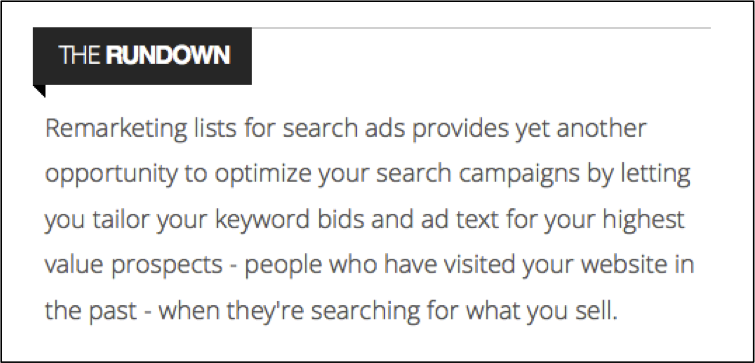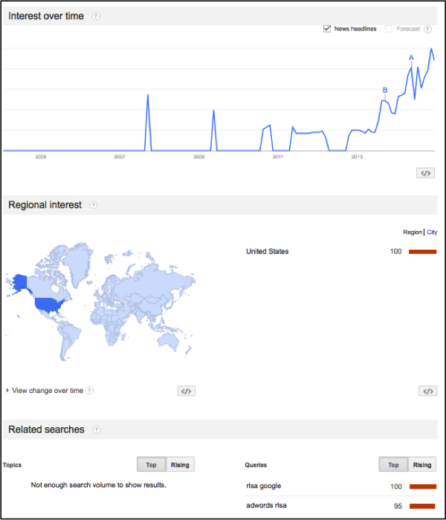Welcome to another edition of series week at PPC Hero! This week we’ll be discussing our predictions for 2015. Sarah starts us off as she foresees an expansion in the usage of Remarketing Lists for Search Ads (RLSA), leading to more of a persona based approach.

According to Google, “49% of customers now visit 2 to 4 sites before they decide to buy and 96% of shoppers won’t make a purchase on their first visit to a site.”
What is RLSA?
Although RLSA has been covered a lot on PPC Hero, and Kristina recently discussed RLSA as a tactic for the Holidays, I am going to give the basics again. RLSA is essentially remarketing in the Search Network. It was rolled out in June of 2013 after being in beta for almost a year. The process is simple. If searchers interact with a website, they receive a cookie and are then put into an audience list. Using this audience list as targeting criteria advertisers can adjust bids, keywords, and copy in campaigns.
Why Use RLSA?
Here are two basic reasons. If a campaign is performing well, an advertiser may want to continue that momentum and try to capture the low-hanging fruit of non-converters. Another reason to use this type of campaign is because the user has already been exposed to a brand and is performing another search. The propensity to convert after two or more interactions with a brand increases in all verticals.
Prediction
So how does all this information lead into my PPC prediction for 2015? We will see more advertisers bid on high funnel and unclear intent keywords in 2015. With another year of data, I believe that most advertisers will have the justification to allocate more budget in this area of PPC.
Take for example a company such as, Reebok, who makes the Nano. The Nano is a well-known brand of Crossfit shoes. While bidding on the word “shoes” is likely too broad for Reebok traditionally speaking, bidding on “shoes” is justified knowing a searcher previously browsed the Crossfit section of the Reebok site. RLSA has equipped the PPC team with the intent of the searcher. Before June of 2013 this targeting method was only available for remarketing display campaigns.
The example above is closer to a persona based marketing approach. Based on the content your customers consume on the site, the brand message is changing for the consumer. This also pushes the PPC teams to be working with the SEO and Social teams to learn what content is gaining traction and how it can feed into new audiences. These new audiences can feed new campaign build-outs.
Building a campaign in this structure does take time. Don’t Panic.
Here Is A Solution
A recommended approach is to map out all the top interactions on the website in an excel sheet. Once you have done that you can begin to create a campaign for each audience and add in the high volume/low intent keywords.

Targeting
Targeting the correct audience is crucial. A best practice is to create a remarketing list for all visitors, and than as many as you want for visitors who have browsed certain product categories or content.
Bid Strategy
Raise bids for all visitors as they have had interaction with the brand. Raising bids 5% – 10% is probably sufficient. Bid even higher on specific category and content visitor lists. Bidding 20% would be more than justified as this potential converter has interacted with specific areas of the website.
Research Keywords
Next perform keyword research. As mentioned above a broad keyword such as “shoes” would be a high volume and low intent keyword for a standard campaign but if you have a separate campaign for each product category this keyword can increase conversions especially with matching ad copy.
Ad Copy Solution
The ad copy should be appropriate and aligned with intent and product category. Bidding on the term “shoes,” knowing the visitor browsed the Crossfit section would dictate the ad copy accordingly just as browsing the running product sections would dictate running ad copy.
As mentioned above, the growth of RLSA and taking the time to build-out campaigns in this manner can be time-consuming. In some ways it threatens the current structure of many accounts. However, as 2014 data has shown, RLSA campaigns are a gold mine of incremental conversions. More advertisers will learn that tactic is indeed working.
Google supports and is promoting RLSA as well. On November 6th, the official AdWords blog contained a link to a white paper about RLSA best practices. The timing on this white paper is no surprise as most advertisers are spending this time of year for 2015 planning. Google wins by supporting advertisers who are willing to bid on broader terms by providing more data to justify deeper adoption of this tactic.
Interest in RLSA overtime has also increased over the year. Here at Hanapin we are seeing more clients come to us with current RLSA campaigns, and as account managers they are part of almost every account structure.

Conclusion
It is believed that in 2015 this level of audience based targeting will grow to a new level. A responsive, well integrated brand that can obtain data about popular content and adjusts PPC campaigns quickly will succeed with this approach. Failing to pay attention to the content groups and audiences on websites will prove detrimental in 2015. Big high volume terms will rise in price for advertisers using a holistic approach, and those that appropriately segment into specific audiences and use the data will win in 2015. The advertisers looking at interactions and content categories can afford the cost of the high volume keywords but furthermore will successfully drive this volume into conversions by way of speaking the language of the searcher.




